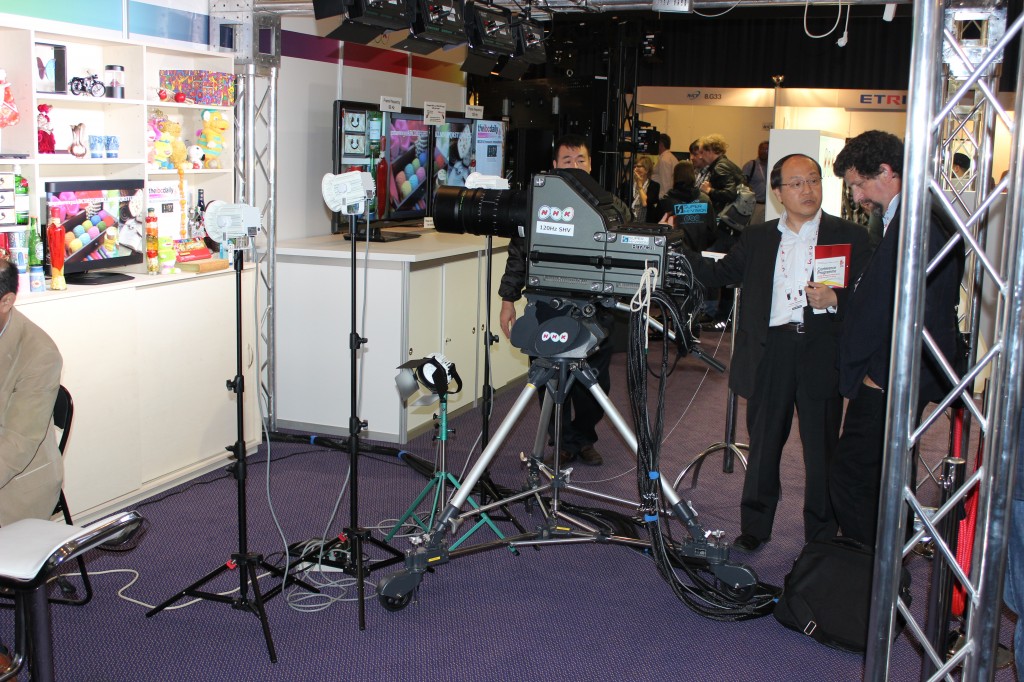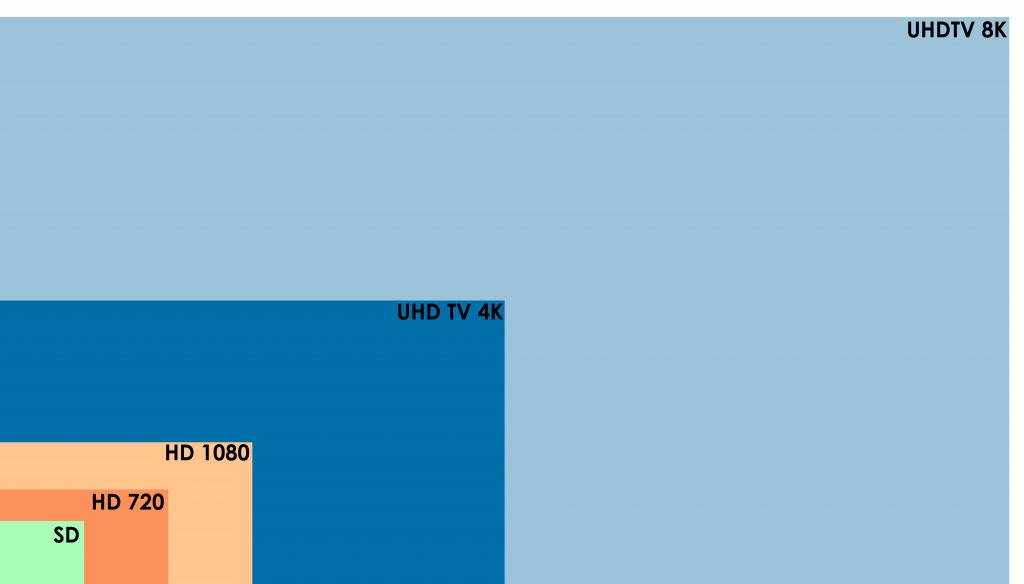For several years, I have enjoyed watching NHK’s technology demonstrations of their outlandish Super Hi-Vision format. With an 8K image (sixteen times the resolution of 1080P HD!) running at 120 frames per second, it’s like IMAX on steroids. And with 22.2 channels of surround sound, the theatrical experience is truly immersive.

(click to enlarge)
But, like many people, I confess that I’ve been treating Super Hi-Vision like a science experiment – something cool and futuristic, but impractical and over-the-top (no pun intended). Imagine my surprise to see that last month Super Hi-Vision has spawned a bona fide ITU standard (Ultra-High Definition, ITU-R BT.2020). What’s more, at the IBC convention in Amsterdam last weekend, the NHK was showcasing a Super High-Vision camera that is actually a lot smaller than a washing machine! Some broadcasters and vendors were even speaking up in support of UHDTV as the “next big thing,” although not without lively debate from the doubters. I found myself wondering if maybe UHDTV might be on the brink of becoming more than just a science experiment.
I also wondered what UHDTV actually is, what variants it supports, and whether it is equivalent to Super Hi-Vision. This post provides a quick summary of UHDTV, what it is and what it isn’t. In a future post I’ll opine about who (if anybody) really needs UHDTV, but first it would help just to understand it.
UHDTV is a specification for a new motion image format derived from Super Hi-Vision, originally developed by NHK’s Science & Technology Research Lab. UHDTV specifies two image sizes: UHDTV1 has 4K resolution, while UHDTV2 has 8K resolution, that can run at a variety of frame rates. Super Hi-Vision is not exactly equivalent to UHDTV2, although it incorporates one variant of UHDTV2 as its image format. Here is a chart I put together to illustrate the areas of equivalence (marked in green) and variance between UHDTV and Super Hi-Vision:
Basically, Super Hi-Vision is equivalent to one of the variants of UHDTV (4320p running at 120 fps) plus 22.2 channels of audio. From my reading, ITU-R Rec. 2020 doesn’t specify anything about audio. Sadly, it appears that the ITU has decided that UHDTV should specify 18 permutations of image size and frame rate. That number increases when you consider color sampling and coding options. It seems to me the ITU should have taken this opportunity to simplify things, rather than repeating the unfortunate approach taken by the ATSC twenty years ago that resulted in fifteen HD variants.
To illustrate the spatial resolution of UHDTV, I have created a colorful graphic (see below) that accurately depicts the relative sizes of SD, HD and UHDTV images. By comparison, whereas an individual frame of 1080p HD content contains roughly 2.1 megapixels, a single frame of UHDTV1 contains roughly 8.3 megapixels, and UHDTV2 contains 33.2 megapixels. How’s that for spatial resolution?

(click to enlarge)
I have always found it interesting that motion imagery can get away with much lower spatial resolution than still imagery. Although scientists have described two phenomena that explain the human perception of motion (the phi phenomenon and beta movement) recent studies indicate that human interpretation of motion video is more complex than had been previously thought. It turns out the brain is not a camera capturing a fixed number of frames per second. The brain has much more work to do to interpret motion video than a still image, and therefore doesn’t have the cycles to ascertain spatial resolution in each passing frame.
This explains why a Bluray disc looks great on my TV when 24 frames per second are flying by. But an individual 1080p frame, at only 2 megapixels, can look blocky. And at only 24 frames per second, fast motion looks jerky. Clearly UHDTV does not have either of these limitations, given its massive spatial resolution and a temporal resolution that ranges up to 120 frames per second.
Not surprisingly, all this resolution comes at a cost. In case you’re wondering, at 120 frames per second, a UHDTV2 sensor is spitting out roughly 4 billion pixels per second at data rates that can exceed 40 Gbit/s. That’s a lot of data! Imagine having to gang together fourteen 3 Gbps dual link SDI signals to carry one uncompressed stream of UHDTV2! This explains why HVEC encoding is seen as necessary to efficiently store UHDTV streams, even though UHDTV is compression agnostic.
So, that’s the quick story on UHDTV. Wikipedia has a good article on UHDTV that I recommend you read, especially if you’re interested in the history of the format. In a future post, I’ll opine on the more difficult questions: is UHDTV practical? And who really needs UHDTV? Stay tuned…
